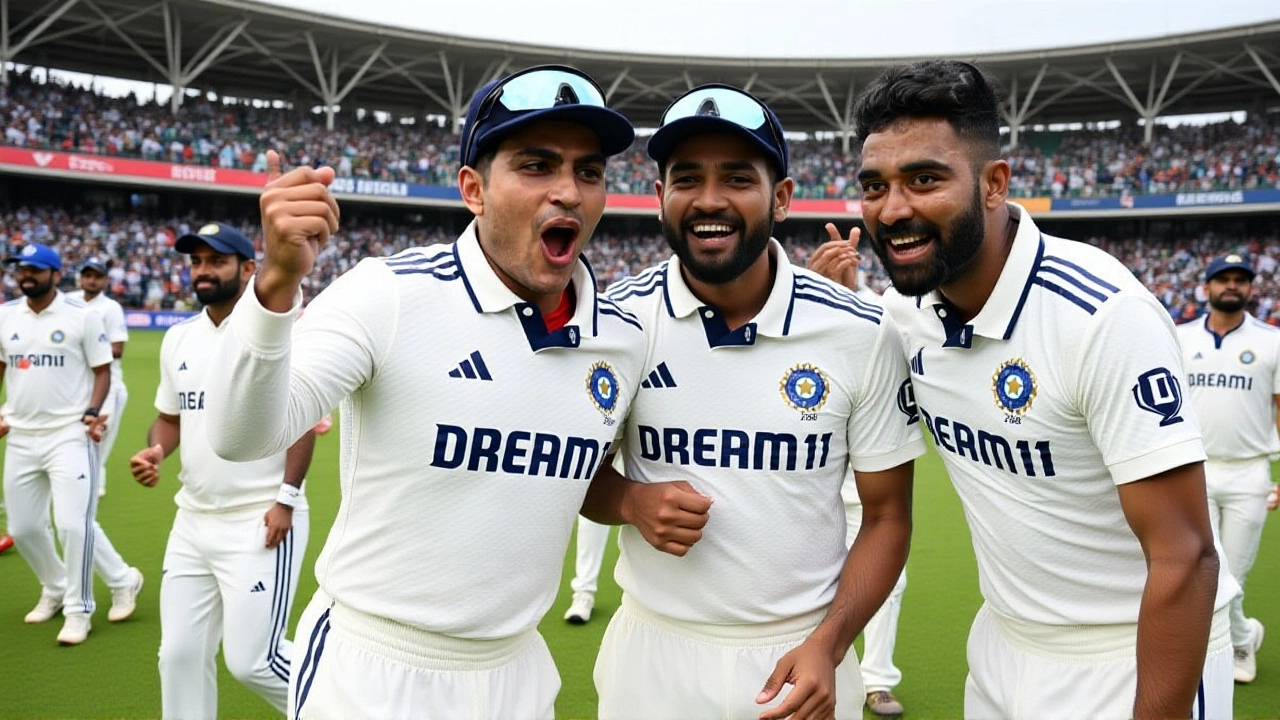Siraj's 4‑wicket haul fuels India's 121/2 lead in 1st Test vs West Indies
-
Okt, 2 2025
-
0 Komentar

When Mohammed Siraj, India’s spearhead fast bowler, rattled the opposition with figures of 4/40, the hosts found themselves comfortably positioned at 121/2 after the first day of the opening Test against the West Indies at Narendra Modi Stadium in Ahmedabad.
India, who won the toss but chose to bowl, dismissed the visitors for 162 in 44.1 overs, leaving them 41 runs short of the target. The early breakthrough set the tone: Siraj clean‑bowled opener Tagenarine Chanderpaul for a golden duck, while Jasprit Bumrah followed with the wicket of John Campbell for just eight runs.
West Indies struggled to build any partnership. The lone resistance came from Justin Greaves, who managed 32 runs before being bowled, but the rest of the line‑up folded under relentless pressure. Kuldeep Yadav chipped in with two wickets and Washington Sundar added another, completing a disciplined spell that left the tourists reeling.
India’s reply – a partnership that steadied the ship
Opening the chase, left‑hander Yashasvi Jaiswal and KL Rahul faced the new‑ball bowler Jayden Seales. Seales, deploying two slips and a gully, struck early, breaking Jaiswal’s wrist with a delivery that spun back in after rain‑delayed play resumed.
India steadied at 83/1 thanks to Rahul’s measured innings. As the overs progressed, Shubman Gill joined him at the crease, while newcomer Sai Sudharsan slipped out to Roston Chase’s good‑length delivery. By stumps, Rahul was unbeaten on 53, having been 39 not out when the innings reached 83/1, and Gill stood firm at the other end.
Seales was the most successful of the West Indian attack, claiming both Indian wickets that fell on Day 1. His disciplined line earned him the figure of 2/36, proving why he was handed the new‑ball duty.
Why the line‑up matters – a new era for Indian Test cricket
This Test marks a watershed moment. It is the first home Test in over a decade that does not feature the stalwarts who built India’s fortress at home: Ravichandran Ashwin, Virat Kohli, Rohit Sharma, Ajinkya Rahane and Cheteshwar Pujara. The selection battle was fierce, with only seven guaranteed starters: Gill, Jaiswal, Rahul, Dhruv Jurel, Bumrah, Siraj and Ravindra Jadeja. The remaining spots sparked a heated debate among pundits, with names like Prasidh Krishna, Nitish Reddy, Devdutt Padikkal, Kuldeep Yadav and Axar Patel in the mix.
Former India captain Mahendra Singh Dhoni weighed in during a post‑match interview, saying, "The transition looks smooth. Siraj and Bumrah have shown they can lead the attack, and the middle order is ready to take responsibility. It’s not about missing legends; it’s about building a new core."
Statistical snapshot – numbers that tell the story
- West Indies 162 all out (44.1 overs)
- India 121/2 (38 overs) at stumps
- Mohammed Siraj 4/40, Jasprit Bumrah 3/42
- KL Rahul 53* (35 balls), Shubman Gill 22* (18 balls)
- First‑innings lead requires just 42 more runs
What lies ahead – Day 2 expectations
With only eight wickets in hand and a modest gap to the target, India can aim to secure a first‑innings lead, a position that historically increases win probability by more than 70 % at the Narendra Modi Stadium. The key battle will shift to West Indies’ seam attack, especially Alzarri Joseph and left‑arm pacer Akeal Hosein, who will look to exploit any fatigue in the Indian top order.
For the visitors, building a partnership of 80‑100 runs could erase the deficit and put psychological pressure back on the hosts. Their middle order, featuring Nkrumah Bonner and the versatile all‑rounder Chris Jordan, will be crucial.
Historical context – India's home dominance over the years
Since the 2015 Adelaide Test, India has taken 12 home series, winning nine, drawing two and losing one. The stalwart quartet of Ashwin, Kohli, Rohit and Rahane was instrumental in that run. Their absence this time has sparked concerns, but the depth uncovered in the current squad suggests the blue‑chip talent pipeline is robust. The last time India played a home Test without any of those five was back in 2012 against England, a series that ended in a 1‑1 draw.
Analyst Sharda Ugra from Cricbuzz notes, "The numbers speak for themselves – India’s bowling attack now has three bowlers with sub‑30‑average in Test cricket. Siraj, Bumrah and Yadav are the new trident, and they’ve already shown they can dismantle a Caribbean lineup."

Frequently Asked Questions
How does India’s reduced target affect their strategy?
Needing only 42 more runs means India can adopt a slightly aggressive stance, allowing the top order to play freely while preserving wickets for later. It also reduces pressure on the middle order, letting them build a solid partnership that could extend the lead beyond 200 runs, a psychologically advantageous margin.
Who were the key performers for West Indies on Day 1?
Jayden Seales stood out, taking two wickets including the crucial dismissals of Jaiswal and Gill. Justin Greaves was the top‑scorer with 32, while Roston Chase contributed a vital breakthrough, removing Sai Sudharsan. Their combined effort, however, couldn’t stop India’s early dominance.
What does this match indicate about India’s new bowling lineup?
Siraj’s 4‑for‑40 and Bumrah’s 3‑for‑42 demonstrate that the speed department remains world‑class despite the retirement of senior pacers. Kuldeep Yadav’s two wickets add a left‑arm angle, suggesting India now possesses a balanced attack capable of exploiting both seam and swing, crucial for sub‑continental conditions.
Why is the absence of Ashwin, Kohli and others significant?
Those five formed the spine of India’s home dominance for a decade, providing experience and leadership. Their absence tests the depth of talent and the team’s ability to perform under pressure. So far, the younger cohort has responded positively, but long‑term consistency will be the true measure.
What should West Indies focus on to bounce back on Day 2?
The visitors need to build a substantial partnership, ideally 80‑100 runs, to erase the deficit. Patience against the new‑ball, rotating the strike, and targeting the occasional loose delivery from Siraj or Bumrah will be key. Additionally, utilizing spinners like Alzarri Joseph early could break the rhythm of Indian batsmen.